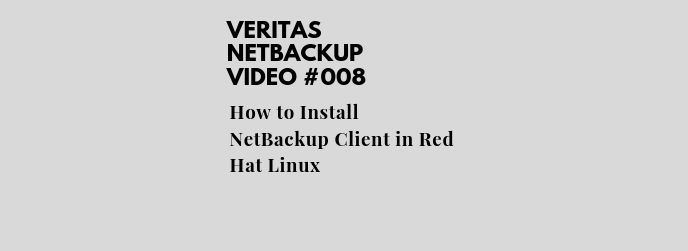This article describes How to Install NetBackup Client in Red Hat Linux
Veritas Technologies LLC provides software solutions. The Company designs and develops enterprise data management software solutions that helps organizations to protect their mission-critical data, as well as offers cloud data management, data protection, compliance readiness, and storage optimization services. Veritas Technologies serves customers worldwide.
Veritas enables organisations to harness the power of their information, with solutions designed to serve the world's largest and most complex mixed environments.
Veritas Technologies empowers businesses of all sizes to discover the truth in information – their most important digital asset. Using the Veritas platform, customers can accelerate their digital transformation and solve pressing IT and business challenges including multi-cloud data management, data protection, storage optimisation, compliance readiness and workload portability – with no cloud vendor lock-in. Ninety-seven percent of Fortune 100 companies rely on Veritas today to reveal data insights that drive competitive advantage.
Technical Director Nigel Dutt approached Edward Forwood of broker Durlacher with a proposal to start a company to develop and sell the product. They consequently acquired the rights to the product and formed kVault Software Limited in late 1999 with initial funding from Durlacher. The four years from 2000–2004 saw greatly improved sales and eventual acquisition by VERITAS Software in 2004. Veritas was subsequently acquired by Symantec in 2005 for $13.5B. However, on February 1st 2016, Symantec completed its sale of Veritas to the Carlyle group for $7.4B and Enterprise Vault again reverted to being a Veritas product.
Red Hat Enterprise Linux (RHEL) is a Linux-based operating system from Red Hat designed for businesses. RHEL can work on desktops, on servers, in hypervisors or in the cloud. Red Hat and its community-supported counterpart, Fedora, are among the most widely used Linux distributions in the world.
Red Hat Enterprise Linux has multiple variants, with server versions for x86, x86-64, PowerPC, Itanium and IBM System z. It also includes desktop versions for x86 and x86-64. As of November, 2011, the latest variant of RHEL is RHEL 6.
Being a Linux distribution, Red Hat Enterprise Linux contains the Linux kernel as well as some applications for performing certain tasks. Like all Linux distributions, RHEL is open source. Thus, people can view its source code, download it and make their own customized versions.
Some of the notable Linux distros that are actually derived from RHEL include CentOS, Oracle Enterprise Linux, Scientific Linux and Pie Box Enterprise Linux.
Red Hat Enterprise Linux (RHEL) is a distribution of the Linux operating system developed for the business market. RHEL was formerly known as Red Hat Linux Advanced Server.
In computing, Veritas NetBackup (called Symantec NetBackup prior to Symantec's divestiture of Veritas) is an enterprise-level heterogeneous backup and recovery suite. It provides cross-platform backup functionality to a large variety of Windows, UNIX and Linux operating systems.
Veritas NetBackup -- known as Symantec NetBackup from 2005 to 2016 -- is a backup and recovery software suite designed for enterprise users. When security giant Symantec acquired Veritas for $13.5 billion in 2005, the NetBackup product was renamed Symantec NetBackup. In 2016, when Symantec spun out its Veritas storage unit, NetBackup again became known as Veritas NetBackup.
NetBackup features a central master server which manages both media servers (containing the backup media) and clients. Core server platforms include Solaris, HP-UX, AIX, Tru64, Linux and Windows.
NetBackup OpsCenter, which comes bundled with the NetBackup 7.0 distribution and replaces the NetBackup Operations Manager[1] (NOM) component used in previous versions, can manage multiple NetBackup environments. NetBackup comes with support for many hardware devices like tape drives, tape libraries, disk units. It supports, among many[quantify] other features, hot backups for major database products like Oracle; it can natively backup and restore the virtual machines of major virtualization products like VMware Infrastructure, can use Network Data Management Protocol (NDMP), and has tape vaulting. NetBackup also enables LAN-free and server-free backups in SAN fabric environments.
NetBackup: #1 in Enterprise Backup Solutions Enterprise data backup and recovery optimized for the multi-cloud.
NetBackup simplifies the protection of your information driven enterprise by automating advanced technologies and standardizing operations across applications, platforms, and virtual environments. Integrated deduplication, replication, and patent-pending virtual machine protection, helps customers improve storage efficiency, infrastructure use, and recovery times.
A single console offers multi-site monitoring, analytics, and reporting which allows customers to standardize operations and risk management. Used by global companies around the world, NetBackup easily scales to protect the largest UNIX®, Windows®, and Linux® environments.
NetBackup includes the following server and client software:
The NetBackup master server manages NetBackup backups, archives, and restores. The master server is responsible for media and device selection for NetBackup.
NetBackup Media servers are the NetBackup device hosts that provide additional storage by allowing NetBackup to use the storage devices that are attached to them.
NetBackup client software that resides on the hosts that contain data to be backed up.
Now you can find some examples in this video.
Please subscribe to support our channel.
To be aware of our new videos please subscribe our channel.
Visit our website https://sdk-it.com
Visit our youtube channel
Watch IT & Learn IT & Apply IT.
Enjoy!






